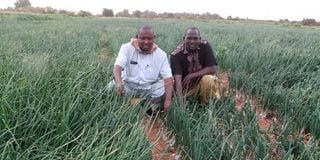Should I grow onions or courgettes?

Mohamed Adan (left), an onion grower on his farm in Mandera on August 23 with a friend.
Many farmers are usually not sure of the next crop to grow after a production cycle.
But they will always look forward to investing in a crop that will bring better returns.
This is the dilemma Farmer Desmond, who called me the other day, was facing as he sought my opinion on whether to plant courgettes or onions.
There are several factors one should consider when choosing a crop to farm. These include the weather conditions, market demand, the perishability of the product and the cost of production.
In this article, we shall discuss how the above factors influence a farmer’s decision on the crop to farm.
The current drought has affected many farmers, especially those who rely on rain to grow crops. However, those who use irrigation have had their production uninterrupted.
Desmond, who is based in Kajiado, uses irrigation, thus after looking at many factors, I advised him to grow onions.
Pests and diseases
And this is why. You see, onions thrive in warm weather conditions like the ones we have currently and is affected by few pests and diseases as compared to courgettes.
Wet conditions normally create a conducive environment for fungal diseases to thrive.
Onions are spaced at 10 to 15cm, depending on the variety and bulb size the farmer intends to achieve. Every seedling counts, as this is what forms a bulb onion, hence the need to plant them well.
Unlike courgettes which require more spacing due to the crop's growth habits, onions are simple to manage because the farmer only needs to control pests, diseases, and weeds after planting.
In onions, herbicides can be used to control weeds in the first month. Once the onions are more than a month old, herbicides should be avoided, as this results in stunted growth.
Onions repel pests since they have a sulphur component. The most common pest that affects onion is thrips, which is easy to control if proper precautions are taken.
But one should also be on the lookout for fungal diseases that affect the crop like downy mildew. This is in contrast to courgettes, which require more attention due to pests such as thrips, aphids and fruit flies that cause crop damage. The fruit flies cause deformation of the fruits and they eventually rot, rendering them unmarketable.
As compared to onions, courgettes are more perishable thus one must have a ready market. Delayed harvesting results in the fruits overgrowing, which renders them unmarketable. This is unlike bulb onions, which when mature necking and curing take place. Curing is the dying process of the leaves of the bulbs to prevent the loss of moisture, which optimises the maximum storage life and the quality of the onions.
With the high shelf-life of onions, the farmer can be able to store the produce for close to two months, as compared to the courgettes waiting for the prices to go up.
When it comes to prices, onions fetch better and can be transported a long distance by road to the market. In addition, the demand for onions is always high as it is consumed almost daily in every household.
Harvesting of onions is done at the end of the production cycle, and this is done once. This is in contrast to courgettes, which are harvested every two to three days depending on market specifications and demand, making them more engaging.
From the above analysis, it is clear that onions are more profitable. Starting next week, I will guide Farmer Desmond in his onion production.





